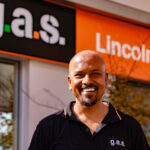Designing brands: think ‘screen’, be seen
Brands need to be made to ‘screen’ and are increasingly designed from Instagram up, says brand building specialist Jonathan Sagar. Voice principal Jonathan Sagar (pictured left) says his agency is increasingly […]
Brands need to be made to ‘screen’ and are increasingly designed from Instagram up, says brand building specialist Jonathan Sagar.
Voice principal Jonathan Sagar (pictured left) says his agency is increasingly building brands from Instagram up that are made to ‘screen’ rather than just be seen. Doing so requires close collaboration with a smart and effective digital agency.
“We used to design brands to be seen. Now we insist brands are made to be ‘screen’,” says Sagar. “For that to happen effectively, brand agencies need to engage in meaningful conversations with digital agencies.
“The assumption today has to be that all brands are fundamentally digital – it’s not an add-on, ‘nice to have’ at the end of the project. That requires brand strategy, not just a design toolkit, and it requires robust content that brings the brand to life across all channels.
“A clear and distinctive strategy must solve a real problem people have. The next step is knowing the story that springs from that, telling it in different places and telling it in ways that are distinct from each other yet work together.”
“Too many brands ring hollow. They’re all personality and no substance. Consumers are increasingly looking for brands that have something interesting to say. “The ‘do or die; of strong brands is their ability to be competitive and to come alive, visually and in conversation.”
Sagar points to brands like Warby Parker, who know who they are and what they stand for, and use content to reinforce their commitments at the same time as they use surprise to re-engage customers.
“Attention spans are short, content is increasingly delivered to mobile channels and consumers are besieged with competitor offers,” says Sagar. “That’s fundamentally changed how people become interested and what they take to heart. It’s seen us form new alliances with companies like Uprise Digital and engage in new conversations about what our businesses can achieve together for our clients.”
Optimising content
Matt Rowe (pictured right), founder and MD of Uprise Auckland, says their business is visibility and measurement. “What we do is directly linked to the acquisition strategy that most companies are following in order to hit their growth goals. Our work focuses on analysing the content experience. We look to optimise the effectiveness of content across the full range of digital touchpoints so that it seamlessly meets the needs of consumers.”
Uprise measures the effectiveness of brands in digital spaces using metrics that provide marketing managers with meaningful data rather than just ‘vanity’ metrics, says Rowe.
“We actively monitor social feedback to determine the meaning of consumer feedback. We are polling interest, often in real time. We also act as a listening post: assessing what is then being picked up by search engines and on social networks and providing feedback to brands on the subjects and ideas they should be looking to amplify.
“Marketing professionals have been lulled into accepting reassurances about their brand’s online performance that don’t stand up to scrutiny,” says Rowe. “It’s easy to be impressed by the numbers – but what we’re constantly examining is the power of the reaction that a specific piece of content is getting. What is getting people’s attention? What are they acting on? What are they sharing? What are they prepared to advocate for? And what does that mean for the brand in terms of buying behaviours?
“We look to rigorously assess the presence that a brand is building, and we approach that in a scientific way.”
“We see the partnership with a company like Voice as a natural fit for us,” says Rowe. “Brand strategy companies create and express stories. We take those stories public in the digital space and in doing that we bring a brand alive.”






